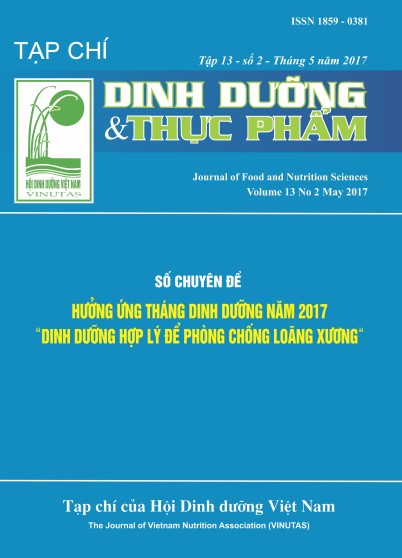OPTIMIZATION OF 𝘚𝘈𝘊𝘊𝘏𝘈𝘙𝘖𝘔𝘠𝘊𝘌𝘚 𝘙𝘌𝘙𝘌𝘝𝘐𝘚𝘐𝘈𝘌 PROPAGATION IN GRAPEFRUIT JUICE USING RESPONSE SURFACE METHODOLOGY
Main Article Content
Abstract
The propagation of Saccharomyces cerevisiae in grapefruit juice has been optimized to obtain maximum population. This study investigated the effects of initial soluble dry concentration (oBrix) and pH of grapefruit juice with the ratio of pure yeast used in propagation as well as NaHSO3 concentration and the duration of pasteurization of grapefruit
juice before reproduction. These experiments were designed by using the response surface methodology (RSM). The research results found optimal values of these factors as follows:
the initial soluble dry concentration (21.07oBx), pH (4.14), the percentage of pure yeast (0.46%) associated with NaHSO3 concentration (109.50 mg/L) and pasteurization time
(38.21 minutes), under which the highest yeast cell density was obtained. The predicted maximum density of yeast cell attained to 8.89387.109 cells/mL after 24 hours of propagation.
Keywords
Propagation, Saccharomyces cerevisiae, grapefruit juice, RSM
Article Details
References
2. Trần Bích Lam (2006). Thí nghiệm phân tích thực phẩm. Nhà xuất bản Đại học quốc gia TPHCM.
3. Lê Văn Việt Mẫn (Chủ biên) (2006). Thí nghiệm vi sinh vật học thực phẩm. Nhà xuất bản Đại học quốc gia TPHCM.
4. Bajpai, P.K. & Margaritis, A. (1985). Kinetics of ethanol production by immobilized cells of Zymomonas mobolis at varying D-glucose concentrations. Enzyme Microb. Technol., 7, 462-464.
5. Nguyễn Đình Thưởng & Nguyễn Thanh Hằng (2007). Công nghệ sản xuất và kiểm tra cồn etylic. Hà Nội: Nhà xuất bản Khoa học và kỹ thuật.
6. Ferraro, L., Fatichenti, F., Ciani, M. (2000). Pilot scale vinification process using immobilized Candida stellata cells and Saccharomyces cerevisiae. Process Biochemistry, 35, 1125-1129.
7. Argiriou, T., Kanellaki, M., Voliotis, S., & Koutinas, A.A. (1996). Kissiris-supported yeast cells: high biocatalytic stability and productivity improvement by successive preservations at 00C. J. Agric. Food Chem., 44, 4028-4031.
8. Eisenman, L. (1998). The home winemakers manual. Del Mar, p179.
9. Constantí, M., Reguant, C., Poblet, M., Zamora, F., & Mas, A. (1998). Molecular analysis of yeast population dynamics: Effect of sulphur dioxide and inoculum on must fermentation, International Journal of Food Microbiology, 41, 169-175.
10. Frivik, S.K. & Ebeler, S.E. (2003). Influence of Sulfur Dioxide on the Formation of Aldehydes in White Wine. Am. J. Enol. Vitic., 54 (1), 32-38


